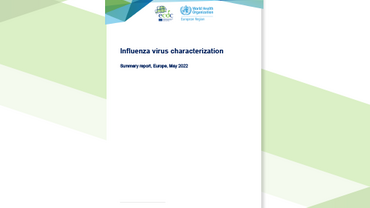Influenza virus characterisation, Summary Europe, September 2014
During the 2013–14 season, A(H1N1)pdm09, A(H3N2), B/Victoria- and B/Yamagata-lineage influenza viruses co-circulated in EU/EEA Member States. The relative prevalence has varied between countries. The WHO Collaborating Centre in London received viruses with collection dates after 31 January 2014 from 21 EU/EEA countries.
Executive Summary
Type A and type B viruses have been received at a ratio of approximately 10:1. A(H3N2) outnumbered A(H1N1)pdm09 viruses at a ratio of 1.4:1.
Recently circulating A(H1N1)pdm09 viruses, in Europe and worldwide, belonged to genetic subgroup 6B. Viruses in this subgroup are antigenically similar to the vaccine virus, A/California/07/2009.
Recently circulating A(H3N2) viruses have fallen within genetic group 3C represented by the recommended vaccine virus for the 2013–14 and 2014–15 seasons, A/Texas/50/2012. Antigenic analysis using antisera raised against cell-propagated H3N2 viruses indicates that the majority of circulating viruses are antigenically similar to those in circulation in the 2012–13 and 2013–14 influenza seasons, but those in a newly emerging genetic cluster, 3C.3a, are poorly recognised by some antisera.
Two genetic clades of B/Yamagata-lineage viruses continue to circulate: clade 3 represented by B/Phuket/3073/2013 and clade 2 represented by B/Massachusetts/02/2012 (the recommended vaccine component for the 2013–14 and 2014–15 influenza seasons). Viruses in clade 3 predominate in those samples collected since 31 January 2014.
Only two viruses of the B/Victoria-lineage were antigenically characterised since the July 2014 report. Neither was recognised well by the antiserum raised against the egg-propagated reference virus, A/Brisbane/60/2008, recommended as a component of quadrivalent influenza vaccines for 2013–14 and 2014–15 influenza seasons. Phylogenetic analysis revealed that all B/Victoria-lineage viruses received in 2014 were in genetic clade 1A, the B/Brisbane/60/2008 genetic clade.
In light of the emergence of antigenically distinct groups of influenza A(H3N2) and the altered prevalence of influenza B viruses, the WHO recommended composition of influenza vaccines for use in the 2015 southern hemisphere influenza season differed from that recommended for use in the 2014–15 northern hemisphere influenza season.





